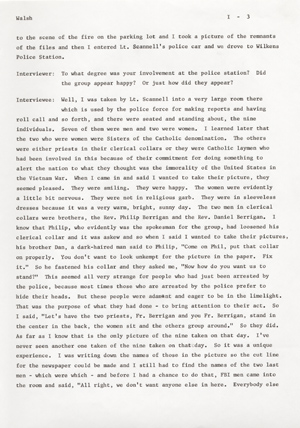 |
The Catonsville Nine's invasion and burning of the Catonsville draft board files: an interview with Jean S. Walsh given on March 30, 1973.
 |
7 / 15 |
 |



| Collection: |
Friends of Catonsville Library |
| Date: |
1973-03-30 |
| Date of Digitization: |
2004-03-31 |
| Source: |
Catonsville Library |
| Original Dimensions: |
28 x 22 cm |
| Creator: |
Walsh, Jean S. |
|
|
Description:
A transcript of a recorded interview with Jean S. Walsh, the editor of Catonsville's local newspaper, the Catonsville Times. She was present at the scene after the burning of draft records in Catonsville on May 17, 1968.
Transcription: to the scene of the fire on the parking lot and I took a picture of the remnants
of the files and then I entered Lt. Scannell's police car and we drove to Wilkens
Police Station.
Interviewer: To what degree was your involvement at the police station? Did
the group appear happy? Or just how did they appear?
Interviewee: Well, I was taken by Lt. Scannell into a very large room there
which is used by the police force for making reports and having
roll call and so forth, and there were seated and standing about, the nine
individuals. Seven of them were men and two were women. I learned later that
the two who were women were Sisters of the Catholic denomination. The others
were either priests in their clerical collars or they were Catholic laymen who
had been involved in this because of their commitment for doing something to
alert the nation to what they thought was the immorality of the United States in
the Vietnam War. When I came in and said I wanted to take their picture, they
seemed pleased. They were smiling. They were happy. The women were evidently
a little bit nervous. They were not in religious garb. They were in sleeveless
dresses because it was a very warm, bright, sunny day. The two men in clerical
collars were brothers, the Rev. Philip Berrigan and the Rev. Daniel Berrigan. I
know that Philip, who evidently was the spokesman for the group, had loosened his
clerical collar and it was askew and so when I said I wanted to take their pictures,
his brother Dan, a dark-haired man said to Philip, "Come on Phil, put that collar
on properly. You don't want to look unkempt for the picture in the paper. Fix
it." So he fastened his collar and they asked me, "Now how do you want us to
stand?" This seemed all very strange for people who had just been arrested by
the police, because most times those who are arrested by the police prefer to
hide their heads. But these people were adamant and eager to be in the limelight.
That was the purpose of what they had done - to bring attention to their act. So
I said, "Let's have the two priests, Fr. Berrigan and you Fr. Berrigan, stand in
the center in the back, the women sit and the others group around." So they did.
As far as I know that is the only picture of the nine taken on that day. I've
never seen another one taken of the nine taken on that day. So it was a unique
experience. I was writing down the names of those in the picture so the cut line
for the newspaper could be made and I still had to find the names of the two last
men - which were which - and before I had a chance to do that, FBI men came into
the room and said, "All right, we don't want anyone else in here. Everybody else
|




